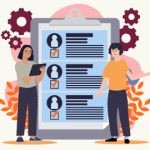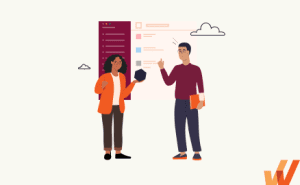
What Is Employee Orientation? +(Benefits, Best Practices, Free Checklist)
- Published: July 13, 2021
- Updated: September 21, 2023


Employees may experience the “first-days-at-a-new-workplace” jitters on joining a new company. A new work environment becomes overwhelming for them if they struggle to navigate basic tasks such as locating office supplies, using new IT systems and apps, figuring out how to sign-up for communication channels, etc. on their own.
To avoid such situations, HR managers need to make new employees feel comfortable in the workplace. This is where a well-organized employee training program called orientation can be of great help to engage new employees with your company ethos.
What is Employee Orientation?
Employee orientation is an act of organizations introducing newly hired employees to their company culture and vision, hierarchy, job responsibilities, different teams, and anything else relevant to a new hire’s job function. An employer’s orientation program provides basic organizational information that employees need to prepare for their new role in a company. Effective employee orientation addresses any questions or concerns employees may have and helps assimilate them comfortably into the company.
Employee Orientation vs. Employee Onboarding
Too often companies fail to understand the difference between employee onboarding and orientation and the terms are used interchangeably. However, both these terms are distinct from one another and are extremely valuable when it comes to retaining your newest hire.
Employee orientation is a one-time event that welcomes new employees to the company and usually goes on for 1-2 days. Consider it like reading the synopsis of a movie or reading the summary of a book. Employee orientation has a few primary purposes such as completing new hire paperwork, providing facility tours, coverage of company policies, presentations, and welcome speeches by senior leadership.
Employee onboarding on the other hand is a series of events that take place for a duration of a week, a month, or even a year in some cases. Onboarding is responsible for truly integrating an employee within an organization. This means getting them up to speed on different tools they’ll use to do their job, introducing them to the people they’ll interface with, making sure they’re familiar with company policies, and making time for clear expectations.
Both onboarding and orientation complement each other and help employees settle in a new work environment and understand the culture they will be working in.

7 Benefits of New Employee Orientation
A good employee orientation program benefits both the employee and employer by educating employees, setting them up for success in their new role, and helping them contribute to the organization right away.
Let’s have a look at few of the benefits of new employee orientation:
1. Reduced stress and anxiety
New employees often feel high levels of stress and anxiety that results from entering an unfamiliar environment with new responsibilities and expectations.
An effective employee orientation educates employees about organizational practices to familiarize them with the new environment and establish a sense of comfort. This allows employees to feel confident and positive in their new job role, leading to a greater probability for success.
2. Increased productivity
Between things like getting to know your organization better and building relationships with coworkers, it takes time for employees to settle into a new role.
An employee orientation program speeds up this process by getting new employees ramped up quickly and enables them to start contributing quickly. An orientation program educates new employees on the company expectations and equips them with information, tools, and support required to succeed in their job role.
When new employees get the essential support from organization and peers, they feel more engaged, and show greater efficiency and productivity levels.
3. Better employee retention
Employee turnover is expensive once you factor in things like the cost to backfill the position. This is why every organization needs to maximize their employee lifetime value.
New employees who have undergone a well-structured onboarding orientation are 82% more likely to remain at a company for up to three years.
Having an effective employee orientation program that displays a clearly laid-out path for employee advancement, professional development, and sponsored education creates a positive impression and is one of the easiest ways to engage your best talent and improve your employee retention.
4. Saves Time for Managers
New employees often have many questions concerning their work responsibilities. Employee orientation is an opportunity to address these questions proactively, so that managers or supervisors do not have to spend their valuable time answering them personally.
5. Improved talent acquisition
Modern employees are not looking for only hefty compensation packages – but are also attracted to a company’s work culture, flexibility, benefits, perks, and development opportunities.
An excellent orientation experience can act as a promoter for your organization’s work culture – and can result in your company poaching top talent. Give your new employees an orientation experience that they find worth sharing with their peers. And when word gets around, you will be able to attract the best talent in the industry.
6. Promotes a better company culture
An employee orientation program provides new employees with a solid support network to reduce concerns when starting a new job. It helps them build trust with the company and coworkers.
Emphasize and embody your company values, encourage employees to chat with their co-workers, and foster an environment of helpfulness. A helpful and welcoming environment boosts employee morale and gives you engaged and motivated employees who are motivated to start contributing to the company.
7. Reinforces Success with Early Employee Engagement
A study by Gallup, the State of the American Workplace, found that the main deciding factor on how a new hire would work out in a new role was their level of onboarding engagement.
The main objective of your new employee orientation program is to improve employee engagement at scale. Putting your employees through engaging orientation motivates them to get started on the new job role and contribute to the company’s long-term mission, thereby increasing the odds of success.
Employee Orientation Checklist
A good employee orientation checklist isn’t about ticking off steps—it’s about designing your new hire’s journey to sweep away the roadblocks.
Here’s an employee orientation checklist that you can use as the foundation of your orientation process. You can layer it with sub-steps specific to your company’s culture and requirements to create a unique experience for your employees.
Before Their First Day
An effective employee orientation plan begins before an employee’s actual joining date.
1. Welcome them to the team
Once the offer is accepted by your new employee, send a welcome email outlining the important details they need to know for their first day. This welcome email includes:
- First-day details like directions to the office, what time to arrive, what’s included on the itinerary, parking directions, and whatever else that will help them arrive with confidence.
- Information about the organization’s history, culture, and values.
- Information on resources like an online employee handbook, mission statements, and company social media to familiarize them with company culture.
- An introduction to the company leaders.
2. Set up internal communications
In a separate email, guide new employees on how to set up company-wide communication channels and software tools such as Slack, Hangouts, Salesforce, Jira, Trello, Asana, or whatever collaborative tools your company uses.
3. Prep their workspace
- Make sure you have everything ready before an employee’s first day. For instance, the workstation, office supplies, business cards, parking passes, and anything else they need to settle in comfortably.
- If the new employee will be working remotely, collaborate with the IT department to make sure that all assets are delivered to them before their first day.
4. Prep the team
Make sure that every employee who will be working with the new hire is informed of their start date. This includes their team, both internal and external, as well as other related departments.
On the first day
1. Settling In
HR will meet the new hire on the first day to complete the paperwork, prepare ID cards, review benefits information and then welcome them with the following:
- A brief tour of the office
- A discussion on the agenda for the day so they know what to expect
- Workstations set up with appropriate equipment and supplies
- Check-in with the hiring manager to review role responsibilities and goals.
2. Provide a chance to meet the team
- Take time to introduce the new employee — both to direct teammates and other departments.
- Schedule informal meetings like team lunch (physical or virtual) to break the ice and start building coworker bonds.
- Assign an “onboarding buddy” in the team to check in on the new hire and address their queries.
3. Orientation Meeting
New hires will be scheduled to attend an orientation meeting on their first day. This meeting is the most important aspect of your employee orientation program – especially for remote teams.
The meeting includes the following:
- Introduction to the company’s mission, functions, and culture.
- Review of company organizational chart.
- Review of employee handbook.
- Benefits plan information, discussion and preliminary enrollment.
- Safety and health policies reviews.
- Anti-harassment policy discussion.
- Policy reviews—pay periods, travel, personal vehicle use, training requests.
- Administrative procedures—security, computer systems and logins, supplies and equipment.
- An overview provided by a management representative from each department about the functions within their department.
- A session on frequently asked questions as well as individual questions from participating new employees.
4. Get them started on a project
- Identify and prepare the first project that your new employee can jump into to get them up to speed.
- Start with something that will give them a quick win and will provide a strong foundation and confidence to keep going.
5. New employee training sessions
The first-day agenda should also include the training sessions your new employees will undergo in the next few days and access to your employee training software portal.
New employee training programs are implemented to significantly improve the time in which employees start making impactful contributions to the organization. These sessions are conducted to provide insights into the job role, familiarity with company policies and procedures, demos on how to use the enterprise tools, etc.
Training should always be tailored to the employee goals and requirements. Personalized training programs take on a learner-centric approach that ensures each training pathway is relevant to the learner’s goals. This approach helps new employees learn quickly and perform better.

On the first day
The last step in your employee orientation process should be to gather feedback to learn more about how you can improve. You can send an evaluation two to four weeks after the employee has joined to find out how they perceived the orientation process.
Once you have gathered feedback, don’t be afraid to make changes based on those recommendations.
7 best practices for new employee orientation
Now that you are familiar with employee orientation, let’s have a quick look at some best practices that will further help improve this process.
- Include realistic information to manage expectations and avoid disappointment.
- Explain how an employees’ role makes a difference to the organization. This will inspire them to boost performance in the long run.
- Communicate the schedule before the first day and have necessary paperwork done in advance.
- Digital Adoption Platforms can be leveraged to provide support to new employees without having to raise support tickets for queries.
- Managers should prioritize ongoing one-on-ones with new employees to provide feedback and keep them on the right track.
- Give personalized attention to make your new employees feel comfortable.
- Keep the first week light, dedicated to familiarizing and information processing.
New employee orientation is an exciting time both for the new employee and the organization. A well-structured and thought-out process makes a significant difference in how quickly a new employee becomes productive.
Consider your orientation program a work in progress and implement new ideas according to the employee feedback to keep improving the process. Over time, you’ll surely set your process straight and lay the groundwork for new employees to become productive team members for years to come.
Thank you for subscribing!


